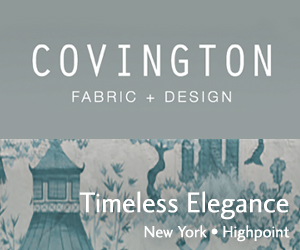DesignTex Embraces Home Furnishings but Stays Green
August 14, 2002
Contract Giant Narrows Focus and Highlights 'Green' Edge to Boost Sluggish Sales
New York — Effective March 1, 2002, DesignTex, a major player in the commercial-only furnishings industry, changed form and took aim at new markets. Following acquisitions of the decorative company Yves Gonnet and Blumenthal and a recent merge with the wallcovering company JM Lynne to form The DesignTex Group, the new company is opening its first residential showroom in Houston in August.
"In the wake of the terrorist attacks in New York, contract has been soft, especially in the corporate arena," said Tom Hamilton, president and CEO of the former DesignTex company, who will stay on in that capacity. "We decided that we needed a different strategy for the future."
The new $150 million DesignTex Group designs, markets and distributes upholstery textiles, wallcoverings, draperies and textile coverings for eight brands — DesignTex, DesignTex Hospitality, JM Lynne, Blumenthal, Yves Gonnet (residential upholstery and drapery), Steelcase Textiles, Essex (wallcoverings), and One Plus One. With the addition of Yves Gonnet and JM Lynne, the company now plans to have its share of the residential market while it continues to increase its strength in contract markets, particularly hospitality and healthcare.
"Of commercial markets, healthcare seems to have been least affected by the downturn," said Hamilton. "And hospitality is picking up a little. We're channeling our energies right now to focus on healthcare, hospitality and residential sales."
The focus will highlight the company's "Sustainable Initiatives," which markets "environmentally responsible" commercial furnishing fabrics — in this industry, DesignTex believes it has the decided edge on green. Brainchild of creative director and executive vice president Susan Lyons, it first introduced its biodegradable Climatex® Lifecycle® fabrics in 1995, and today, many of the company's commercial products can be completely composted or perpetually recycled.
In fact, the 41-year-old DesignTex boasts the first and only "completely sustainable" upholstery products in its William McDonough Collection for contract. The collection features eight upholstery styles that are fully compostable after their useful life, leaving behind no carcinogens, persistent toxic chemicals, heavy metals or other toxic substances. As more and more customers take an enlightened stance on environmental issues, DesignTex sees its share of the market swelling. But there are different shades of green. Although price points for such products can be high, not all environmentally responsible products are necessarily expensive, insisted Hamilton.
"Because of advancements in technology," he explained, "customers do not need to pay a premium for them. In fact, many of our environmentally responsible fabrics are 10 percent cheaper today than when we introduced them."
The company has also redesigned polyester to eliminate the antimony that makes traditional polyester detrimental to the environment. The new polyester, Climatex Lifeguard FR, the first compostable inherently flame retardant textile construction on the market, has been licensed to the Canadian mill Victor Innovatex. The first Climatex Lifeguard FR products were introduced by DesignTex last summer and by Steelcase Textiles earlier this year.
But in 2001, DesignTex may have laid its save-the-earth trump card on the table — it made its system of manufacturing 100 percent bio-degradable fabrics, until then proprietary to a collaboration of DesignTex, McDonough Braungart Design Chemistry (MBDC) and the Rohner Textil Mill, available to the entire industry.
"In sharing its proprietary research and development with its competitors, DesignTex embraces a new business model that McDonough characterizes as 'co-opetition' — sharing information to further the development of sustainable products and business practices," wrote the company in the press release.
In the same press release, DesignTex claimed that "leadership, not ownership" is important in today's business environment.
Underscoring its plan to increase its leadership — and market share — in that business environment, the company has also launched two new companies, DesignTex Euro Ltd, based in London, and DesignTex Canada Ltd, based in Toronto. According to Hamilton, the company is not only increasing market share in existing markets with its green technology, and expanding from commercial into residential markets, but also plans to extend its geographical reach. While sales are off in much of Asia, he said he is optimistic about markets in Korea and China in the coming months.
The DesignTex Group currently has 29 service centers in the U.S. and Canada and representation in 15 countries around the globe. F&FI
New York — Effective March 1, 2002, DesignTex, a major player in the commercial-only furnishings industry, changed form and took aim at new markets. Following acquisitions of the decorative company Yves Gonnet and Blumenthal and a recent merge with the wallcovering company JM Lynne to form The DesignTex Group, the new company is opening its first residential showroom in Houston in August.
"In the wake of the terrorist attacks in New York, contract has been soft, especially in the corporate arena," said Tom Hamilton, president and CEO of the former DesignTex company, who will stay on in that capacity. "We decided that we needed a different strategy for the future."
The new $150 million DesignTex Group designs, markets and distributes upholstery textiles, wallcoverings, draperies and textile coverings for eight brands — DesignTex, DesignTex Hospitality, JM Lynne, Blumenthal, Yves Gonnet (residential upholstery and drapery), Steelcase Textiles, Essex (wallcoverings), and One Plus One. With the addition of Yves Gonnet and JM Lynne, the company now plans to have its share of the residential market while it continues to increase its strength in contract markets, particularly hospitality and healthcare.
"Of commercial markets, healthcare seems to have been least affected by the downturn," said Hamilton. "And hospitality is picking up a little. We're channeling our energies right now to focus on healthcare, hospitality and residential sales."
The focus will highlight the company's "Sustainable Initiatives," which markets "environmentally responsible" commercial furnishing fabrics — in this industry, DesignTex believes it has the decided edge on green. Brainchild of creative director and executive vice president Susan Lyons, it first introduced its biodegradable Climatex® Lifecycle® fabrics in 1995, and today, many of the company's commercial products can be completely composted or perpetually recycled.
In fact, the 41-year-old DesignTex boasts the first and only "completely sustainable" upholstery products in its William McDonough Collection for contract. The collection features eight upholstery styles that are fully compostable after their useful life, leaving behind no carcinogens, persistent toxic chemicals, heavy metals or other toxic substances. As more and more customers take an enlightened stance on environmental issues, DesignTex sees its share of the market swelling. But there are different shades of green. Although price points for such products can be high, not all environmentally responsible products are necessarily expensive, insisted Hamilton.
"Because of advancements in technology," he explained, "customers do not need to pay a premium for them. In fact, many of our environmentally responsible fabrics are 10 percent cheaper today than when we introduced them."
The company has also redesigned polyester to eliminate the antimony that makes traditional polyester detrimental to the environment. The new polyester, Climatex Lifeguard FR, the first compostable inherently flame retardant textile construction on the market, has been licensed to the Canadian mill Victor Innovatex. The first Climatex Lifeguard FR products were introduced by DesignTex last summer and by Steelcase Textiles earlier this year.
But in 2001, DesignTex may have laid its save-the-earth trump card on the table — it made its system of manufacturing 100 percent bio-degradable fabrics, until then proprietary to a collaboration of DesignTex, McDonough Braungart Design Chemistry (MBDC) and the Rohner Textil Mill, available to the entire industry.
"In sharing its proprietary research and development with its competitors, DesignTex embraces a new business model that McDonough characterizes as 'co-opetition' — sharing information to further the development of sustainable products and business practices," wrote the company in the press release.
In the same press release, DesignTex claimed that "leadership, not ownership" is important in today's business environment.
Underscoring its plan to increase its leadership — and market share — in that business environment, the company has also launched two new companies, DesignTex Euro Ltd, based in London, and DesignTex Canada Ltd, based in Toronto. According to Hamilton, the company is not only increasing market share in existing markets with its green technology, and expanding from commercial into residential markets, but also plans to extend its geographical reach. While sales are off in much of Asia, he said he is optimistic about markets in Korea and China in the coming months.
The DesignTex Group currently has 29 service centers in the U.S. and Canada and representation in 15 countries around the globe. F&FI
















